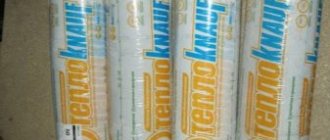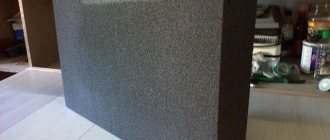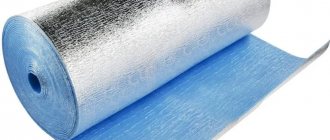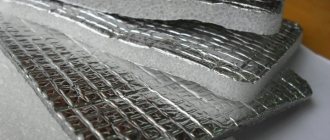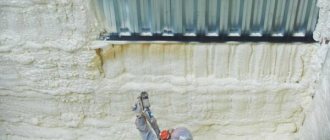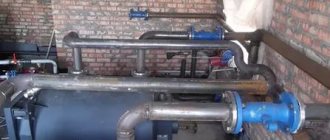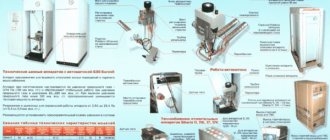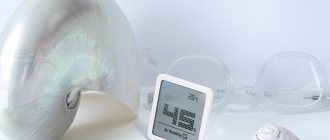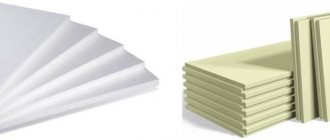Foam glass is an inorganic, environmentally friendly, high-strength and lightweight insulation material that looks like pumice. The chemical composition of foam glass is identical to household glass based on oxides of silicon, potassium, sodium, aluminum, magnesium, and calcium.
Foam glass was introduced in 1932 at the All-Union Conference on Innovations in Construction. The material was presented by the legendary physicist-crystallographer A.I. Kitaygorodsky. By the end of the thirties, the French, British, Czechs, Germans and Americans already had patents for the production of foam glass. The war slowed down research in this area and the first factories appeared in the Union only in the seventies. However, production volumes exceeded 100,000 m3 per year and the product was in demand.
The production of foam glass is extremely energy-intensive and difficult to control technical parameters, so it became unprofitable in the late 80s - of the four factories, only Gomelsteklo remained (apparently, it closed the line quite recently). But over the past 5 years, Russia and Ukraine have started producing a variety of foam glass at prices competitive with European ones. We’ve sorted out the history of the material in a nutshell, let’s move on.
A little history
Foam glass was invented by the honored worker of technology and science Isaac Ilyich Kitaygorodsky. The professor specialized in glass production technology, because he considered it the material of the future. The professor's invention was improved by US specialists in the 40s. Initially, foam glass was used as a floating material. But it soon became clear that it demonstrates excellent heat and sound insulation properties, is easily glued together, and is easy to process. Therefore, it was decided to use it in construction.
Thus, in Canada a building appeared, created from concrete slabs with a layer made of cellular glass. This event happened back in 1946. The experiment was very successful. The material has received well-deserved recognition. But, to the great regret of the inventor, it did not gain popularity in Soviet countries, since the cost was high and the production technology had not been developed. It was manufactured in the USSR, but the quality of the product left much to be desired, which led to the closure of factories.
But currently the production of this product is in full swing!
Dry screed Knauf
Knauf dry flooring consists of gypsum fiber slabs (floor element) 2 centimeters thick and a ready-made backfill of expanded clay chips (fraction size 1-4 millimeters). Double gypsum plasterboards with a seam connection simplify installation and make it possible to produce a floor that meets all modern requirements for strength and safety.
The main advantages of using double Knauf sheets for screeding:
- Due to its low weight, the dry screed design is applicable in multi-storey buildings without additional reinforcement of the floors.
- This floor has maximum acoustic and thermal insulation.
- The Knauf screed is quickly and easily installed.
- The strength of the structure reaches 500 kilograms per square meter.
- Laying the floor covering can be done immediately after installing the dry floor.
- There are no wet processes.
- Expanded clay and Knauf floor elements are environmentally friendly and fireproof materials.
How is foam glass produced?
Broken glass and recyclable materials are ground with a blowing agent (coal, coke, soot, anthracite) and poured into molds, mixed with other additives. The mold is filled approximately 10%; the entire volume will be filled during the formation of glass foam. Firing takes place in a tunnel kiln at a temperature of about 1000°C. During the glass melting process, the blowing agent increases the mass by 14-15 times and the mold is filled.
Foam glass production line of a German plant
For foam glass granules, the technology is different: the cullet is washed and dried, crushed, then ground with foaming agents and the charge is granulated. Next, the granules are dried and placed in rotating kilns, where the granules are sprinkled with quartz sand to prevent soldering. Foaming takes place at temperatures from 780 to 820°C.
The cost of foam glass is very high due to the energy intensity of production and expensive equipment (equipment for a line for 20 m3 per day costs about $1 million).
Types of foam glass:
- Blocks (slabs)
- Granules
- Shapeless battle (construction rubble).
Advantages of foam glass
- Very long service life. This material can last about 100 years, which is indicated in its characteristics. So far, such a long period has not been recorded, if only because so much has not passed since the day of its invention.
- Lack of oxidation due to the presence of oxides such as silicon oxide, sodium oxide, calcium oxide, magnesium oxide, aluminum oxide.
- It is not subject to erosion, since the composition does not contain substances washed out by water.
- No exposure to temperature changes. Withstands any temperature changes in any climate zone and at any time of the day or night.
- Does not deform as a result of mechanical stress.
- Since the material does not contain biological compounds, it is not exposed to fungus, mold and microorganisms.
- High strength. Unlike heat-insulating materials such as polystyrene foam, the strength of foam glass is several times higher. Due to its strength, it does not require additional fastenings during installation.
- Constancy of size. The cells that make up the block do not allow it to change under the influence of any factors. Not only the geometry of the block does not change, but also the thermal insulation properties. This means that according to its characteristics, the material of the blocks is close to concrete or brick.
- Consistency over time. Strength, thermal conductivity, geometry - all this has not changed for at least 50 years. The primary parameters were preserved as if not so many years had passed.
- Resistance to chemical and biological influences. Glass, as you know, is not exposed to chemicals. It is not needed by harmful bacteria or fungi. This is very suitable for unventilated areas (basement, roof top, storage areas). Serves as an excellent barrier to pests in places such as industrial refrigerators and vegetable and grain storage areas.
- Non-flammable material. Glass is melted in furnaces at a temperature of about 1000 degrees Celsius. In the event of a fire and reaching such a temperature, it will also only melt without releasing any harmful substances.
- Moisture resistance. Glass does not allow water to pass through in any direction. When finishing walls, this moment is convenient in terms of creating an additional water barrier.
- Sanitary safety. The cells have microholes through which the material “breathes.” This creates a certain indoor microclimate and air purity. Creating environmental cleanliness and sanitary safety is an important point in public buildings.
- Noise insulation. Having a number of positive aspects, foam glass also has good sound insulation.
Disadvantages of the material
The disadvantages of foam glass may be precisely what may prevent its use in a particular case. The choice of material according to its main parameters also characterizes the attitude towards it.
This is especially important if the slightest characteristic can push us away from the insulation already chosen, for example. Such points may be thermal conductivity, moisture conductivity, environmental characteristics, sanitary safety.
Here are the disadvantages of foam glass:
- Despite its long life, the material has a high production cost. Production requires modern high-tech equipment, which leads to its rise in price. Other insulation materials are inferior to it in some ways, but they are much better in price.
- The material is very fragile and the slightest deviation from the recommendations for working with it leads to cracking.
- Unlike modern materials, there is no vapor conductivity. And if the material itself is not susceptible to fungus and mold, then the wall may become infected.
- It is unlikely that hydrofluoric acid or alkalis will come into contact with the material, but nevertheless this is what he is afraid of.
- Not subject to tension or compression can lead to cracking during movement of other components of the structure (walls, ceilings, floors).
- No matter how foamed the glass is, it is still glass, which means the blocks are quite heavy. The weight of the blocks greatly affects the entire structure of the construction site. Therefore, it is necessary to calculate the loads on supporting structures in advance and very carefully.
- The material of the blocks does not withstand shock loads at all. If, for example, the block was cracked and then joined together during installation using cement mortar, this will not save it from exposure to moisture. In fact, it becomes unsuitable as insulation.
- Greater durability also serves a disservice in this case. The material itself may last a long time, but the materials from which the building is constructed may not last. When making repairs or dismantling a building, it will be difficult to keep blocks of this type of insulation intact. That is, durability in this case is a big and expensive problem.
Main characteristics
Foam glass has excellent technical parameters:
- Density and mass. The material was originally used as a floating material, because its density is very low - 100-250 kg/m³ (for comparison, for wood this figure is up to 750 kg/m³). Foam glass weighs about 70-170 kg/m³.
- Thermal conductivity and sound absorption. The material can serve as insulation, since at room temperature it has low thermal conductivity - 0.04 W/m*K. In addition, when installing the material, no cold bridges arise.
- Noise insulation. The sound absorption level of foam glass with a thickness of 100 mm is 52 dB (approximately at the level of mineral wool).
- Temperature resistance. Foam glass is not afraid even of extreme temperatures (up to +400 degrees). The deformation temperature is +450 degrees, and after introducing special heat-resistant additives into the composition, it will not collapse even at +1000 degrees. The material also tolerates freezing and exposure to liquid nitrogen at a temperature of -200 degrees.
Technical characteristics of foam glass
Foam glass is produced in the form of 45x60 cm slabs with a thickness of 10, 12, 60, 80 cm. Blocks of various sizes and other forms of material are also on sale.
Water and vapor tightness
Foam glass is waterproof - it practically does not absorb liquids, does not increase in size, does not swell, and at the same time protects the remaining parts of the structure from leakage. The water absorption rate is less than 2%, which is considered very low. In addition, foam glass acts as a vapor barrier, since its vapor permeability tends to zero (0–0.005 mg/m*h*PA).
Stability
Due to minimal thermal expansion (about the same as steel and concrete), foam glass adheres reliably to the base. Internal deformation stresses between the foam glass layer and the base material do not appear.
Important! These properties, as well as minimal shrinkage, allow foam glass to maintain stable dimensions throughout its entire service life.
Strength
The entire thickness of the material is permeated with small pores filled with air. The average diameter of the bubbles is 2000 microns, the thickness of their walls is 20-100 microns. Despite this, foam glass has relatively high bending strength (0.4-0.6 MPa) and compressive strength (0.7-4 MPa).
Chemical resistance
Foam glass is not afraid of exposure to household chemicals and other chemicals. The exception is hydrofluoric acid, but the latter is quite rare and is used mostly in the aluminum industry.
The properties of foam glass are not influenced by the biological environment, since the development of life inside it is impossible. Among other things, foam glass is an abrasive material and is not subject to wear or tearing by animals or insects.
Safety and Flammability
Foam glass is made from sulfate-containing glass; hydrogen sulfide from reduced sulfur remains in its cells. Hydrogen sulfide is formed by the interaction of sulfides from the feedstock with water vapor during hydrolysis. The amount of this substance in foam glass is minimal, and its release occurs only when cutting a block.
Many manufacturers use other types of glass as raw materials to make the material to make foam glass more environmentally friendly. This inevitably entails an increase in product prices.
Important! The material is suitable for use and is considered fully recyclable and recyclable.
Foam glass is not subject to combustion. Moreover, if a fire occurs, it prevents the fire from spreading and helps stop the fire. Under the influence of high temperatures, the material does not emit toxins or harmful fumes.
Scope of application
Foam glass, due to its properties, is used for insulation:
- private houses;
- outbuildings;
- sports complexes;
- underground structures;
- industrial buildings;
- medical institutions;
- educational institutions;
- office facilities;
- recreational facilities - (for example, for baths, water parks, etc.).
The scope of application of the material is very wide, since the thermal insulation material is impeccable:
- to insulate the ceiling: the attic floor is filled with cement-sand mortar, and then the slabs are laid, after which a reinforcing screed is made;
- for walls: the surface is prepared, special glue is applied, the product is applied, pressed tightly and covered with plaster;
- for the floor: a layer of sand (3–5 cm) is poured, thermal insulation is laid or backfilled, joints are sealed, screed is applied, the covering is installed;
Yes, the material is popular due to its good technical characteristics.
Advantages
The material has many advantages. Let's look at the main ones.
- Safety. Does not contain substances harmful to the human body.
- Environmentally friendly. Made from environmentally friendly raw materials.
- Hygiene. Has antiseptic properties.
- Durability. Service life - more than 100 years.
- Versatility. It is used for insulation of any buildings.
- High adhesion. Combines with a lot of building materials.
- Biological passivity. He is not afraid of rodents, insects and microorganisms.
- Resistance to the negative effects of climatic factors. He is not afraid of temperature changes, precipitation, UV, etc.
- Resistance to mechanical factors. It does not deform and does not lose its properties, since it can withstand impacts and high loads.
- Unaffected by chemical factors. Does not react to acid.
- Resistance to thermal factors. Foam glass is an absolutely non-flammable insulation material.
- Ease of processing. It cuts perfectly with a regular hacksaw.
The material is worthwhile, but there are drawbacks and there are many of them, unfortunately.
roof insulation with foam glass
Pipe insulation with foam glass material
A typical application of foam glass is pipe insulation. Typically this is a 5 cm thick material with an aluminum foil layer. Used for hot or cold applications ranging from – 230 °
C up to +500
°
C.
Advantages: waterproof, will not lose its insulating properties if it gets wet. If it gets wet, it dries without loss of quality. Foam glass is better for higher temperature pipes compared to fiberglass. More durable than fiberglass.
Disadvantages: very expensive material, labor-intensive work. Cannot be used on pipes subject to vibration, which will turn foam glass into dust.
What is Foamglas foam glass?
Foamglas is a cellular glass insulating material that is impervious to moisture, inert, insect and vermin resistant, strong and reasonably insulating. Foamglas can be used to insulate roofs, walls and as underlays, including under slabs. Its high compressive strength makes it particularly suitable for roof terraces, green roofs and parking areas.
Using Foamglas as external foundation insulation.
Compared to composite thermal insulation materials, Foamglas foam glass is 100% glass, made mainly from sand, limestone and soda ash. The ingredients are melted into molten glass, which is cooled and ground into a fine powder. Powdered glass is poured into molds and heated (below the melting point) and the "sintering" process causes the particles to stick tightly to each other.
A small amount of finely ground carbon black is then added and the material is heated in the same way as in the pulping process. Here carbon reacts with oxygen to create carbon dioxide, which creates the insulating bubbles in Foamglas. In the resulting material, CO2 makes up more than 99% of the gas in the honeycomb of the product.
If you scratch a piece of Foamglas (your fingernail can easily cut it), you will notice a slight rotten egg odor from hydrogen sulfide. Ferrous sulfate is used in the manufacturing process and the process produces small amounts of hydrogen sulfide. You won't have to breathe in much of the hydrogen sulfide since it's tightly locked into the cellular glass - in fact, even after 30 years in a fresh scratch, Foamglas produces the same smell. This is proof that the foam glass chambers are absolutely sealed.
Foamglass
Foamglas foam glass does not contain blowing agents that deplete ozone or contribute to global warming. There are no flame retardants or other additives to improve fire resistance. 100% inorganic Foamglas material is inert and fire resistant.
Foam glass installed for insulation under a concrete slab
The product has sufficient compressive strength for use under any concrete slab - an application currently dominated by extruded polystyrene (XPS). Foam glass is better than XPS because, in addition to being free of chemicals, Foamglas is completely impervious to moisture (water and steam), does not support mold growth, blocks radon, and does not keep termites or rodents inside.
Flaws
Of course, every raw material has its negative aspects. Foam glass is no exception. Before purchasing material, you need to carefully study the negative aspects.
- High price. The production of raw materials requires innovative high-tech equipment, which leads to its rise in price. And also the production of foam glass requires high energy costs.
- Fragility. The raw material, despite its strength, is very fragile, which leads to cracking if installation recommendations are ignored.
- Lack of steam conductivity. Foam glass, as was said, is not subject to the destructive effects of biological factors, but the surface under it is easily damaged.
- Fear of alkalis and hydrofluoric acid. Cellular glass, like an aspen leaf, trembles at the “sight” of alkalis and hydrofluoric acid, since they are capable of destroying it.
- Heaviness. The raw materials are relatively heavy, which negatively affects the building structure.
- Durability. Of course, a long service life is a plus. But the materials used to construct the facility are unlikely to last more than 100 years. This means that the structure must be repaired periodically, and cellular glass is not intended to be reused. Which exit? Replacing insulation.
- Low impact strength. Cellular glass does not withstand even light impacts. Mechanical influence is the “death” of the material. Of course, if the insulation is in the structure, it is not afraid of impacts. He is afraid of them during transportation, unloading and installation.
- Impossibility of “reanimation”. If the glass is damaged, it can be taken to a landfill. It is impossible to glue or cover up the cracks.
Properties played a cruel joke on cellular glass, turning a huge number of advantages into disadvantages.
Foam glass price
I will give the cost of Ukrainian foam glass in dollar terms.
| Foam glass in small blocks 250x120 mm | ||
| Thickness, mm | Vapor permeable $/m2 | Vapor tight $/m2 |
| 65 | 9.11 | 10.72 |
| 88 | 12.30 | 11.7 |
| Foam glass in slabs 600x450 (450x450) mm | |||
| Thickness, mm | Vapor permeable, $/m2 | Vapor-tight 1st grade, $/m2 | 2nd grade, $/m2 |
| 30 | 4 | 7.15 | 6.8 |
| 40 | 5.2 | 9.5 | 8.7 |
| 50 | 6.6 | 12 | 11.4 |
| 60 | 8 | 14.3 | 13.7 |
| 70 | 9.2 | 16.7 | 16 |
| 80 | 10.55 | 19.1 | 18.2 |
| 100 | 13.2 | 23.9 | 22.8 |
| 120 | 15.8 | 28.6 | 27.4 |
| Foam glass processed in slabs 600x450 mm, with bitumen coating or plastered | |
| Thickness, mm | Price, $/m2 |
| 50 | 11.2 |
| 60 | 13.5 |
| 80 | 17.9 |
| 100 | 22.4 |
| 120 | 26.9 |
| Fractionated foam crumb (fraction up to 150 mm) | 57.8 $/m3 |
I would consider foam glass insulation as a backfill for well laying and as a waterproofing blind area - in these places the use of expensive material is 100% justified. But I would not use foam glass crushed stone.
Kinds
Today there are two types of foam glass - granular and block.
In addition, there are three types of granular insulation:
- foam glass gravel;
- foam glass crushed stone;
- foam glass sand.
There are also three types of block insulation:
- slabs (foam glass sheets);
- blocks;
- shells (shaped foam glass).
If we compare the thermal properties of granulated and block glass, of course, gravel, crushed stone and sand are inferior to slabs, shells and blocks. But, nevertheless, granular insulation is more popular due to its relatively low price.
Prospects for the use of foam glass in individual construction
Comparing all the pros and cons, the conclusion suggests itself: this material still has a long way to go. The material is universal both in its characteristics and areas of application.
Today the material is expensive for individual construction. If we talk about the prospect of its use in the future in this area, then Western developments and the use of foam glass speak about this.
In Germany, the production of prefabricated houses from monolithic sections has already been established. The thickness of the walls of such a house is 30 centimeters. This thickness is sufficient for use in any climate zone. The manufacturer claims that the houses are easy to assemble . The relative lightness of the blocks will allow them to be assembled quickly and without the need for heavy cranes. This technology for houses in places of catastrophes and natural disasters will be useful.
And what is also important is that these houses are not “temporary buildings”, but completely permanent housing with all amenities.
Features of using foam glass in building insulation
Let's look at the features of insulation using some examples.
- Insulation of walls . It is possible to insulate with such material both from the outside and from the inside of the building. There is nothing complicated about working with foam glass blocks. Old facing material, dirt and dust are removed from the walls. After this, a layer of special glue or cement mortar is applied to the wall (as when working with tiles). Place a block on the layer of adhesive and press it. You can, of course, further strengthen it with dowels, but this may damage the material. The top is covered with a layer of plaster. No additional vapor barriers or waterproofing are needed.
- Insulation of floors . To insulate floors, blocks, crumbs or foam glass granules are used. The best option is blocks. First, the base is covered with sand five centimeters thick. You can now lay slabs (blocks) on the sand. The joints can then be sealed with foam. We need to make a reinforced screed on top of our heat-protective coating. And finally, a wooden floor is made.
- Roof insulation . The roof is one of the most exposed elements of a home to moisture. In this case, insulation with foam glass is optimal. If the attic is not residential, then it is enough to insulate the attic floor according to the example described above.
- Insulation of the foundation . Insulation of the foundation is the main point in building a house. A big problem for many areas located in swampy or low-lying areas is flooding. In this case, the foundation begins to become damp, and from it the walls begin to damp. All this begins to rot, becomes covered with mold and collapses over time. You can, of course, make permanent repairs, but this is not only a way out of the situation, but still will not reverse the destruction that has begun. Therefore, at the stage of constructing the foundation, it is necessary to cover the foundation both from the street side and from the inside of the basement. We already know how to cover a wall.
- Bathroom insulation . A bathhouse on a summer cottage is an invariable and important attribute of relaxation. A bathhouse can be a source of an aggressive environment due to high humidity and temperature changes. Foam glass slabs may be ideal for such premises. The process of insulating the walls of structures such as a bathhouse is no different from insulating walls in ordinary rooms.
To really understand how different foam glass is from other insulation materials, you just need to compare their characteristics.
Comparative characteristics of heat-shielding materials
Expanded polystyrene advantages - low price, low thermal conductivity. Disadvantages - low (less than mineral wool) vapor permeability, increased labor intensity in terms of adjusting the material, high flammability. The only place where it can be used is in damp, even wet places when insulating the facades of stone buildings. Not suitable for wooden buildings.
Mineral stone wool advantages - withstands temperatures up to 1000 degrees Celsius, does not absorb moisture, high degree of resistance to mechanical stress.
Extruded polystyrene foam advantages - low thermal conductivity, high mechanical strength, no capillarity, no water absorption, resistance to temperature changes, durability. Disadvantages - lack of vapor permeability .
Foam concrete and aerated concrete advantages - they are not afraid of dampness, regulation of air humidity in the room due to the release and absorption of moisture (creating a microclimate), high sound insulation, good thermal insulation (3–3.5 times higher than that of brick), low labor intensity when working with them , non-flammability of materials, easy to process, durability.
Fiberglass (glass wool) advantages - fire safety, ease of working with them, low thermal conductivity, does not rot, is not afraid of moisture (the ability to both absorb and release moisture). Disadvantages are the need to make gaps during installation to remove moisture, aging and destruction of the structure of the material.
The advantages of cork materials are environmental friendliness, the ability to be used for decoration, insulation for floors and interior walls. Disadvantages - high cost.
Foam foil material has advantages: low weight, low thermal conductivity, ease of use. Disadvantages - vapor tightness and gas tightness (walls “do not breathe”).
Tips and tricks
Below are some tips on how to improve the efficiency of foam glass.
When purchasing this material, you should take into account the thermal insulation parameters of the product. For example, for walls built of brick or concrete, 12 cm thick slabs are used, and for wood structures, 8-10 cm of material is sufficient
For interior work, it is worth choosing 6 cm slabs. They are attached with glue and reinforced with steel brackets and thin dowels.
Today, foam glass meets all the requirements for building materials in terms of their reliability and safety.
To learn how to insulate a floor with foam glass, see the following video.
How can you replace “Tsinkar”
There are many products similar to this rust converter that are sold. If the oxide layer is small, try making the following composition at home:
- mix water and citric acid in equal proportions;
- add a tablespoon of alkali, that is, ordinary baking soda, to the solution;
- wait 30-40 minutes;
- treat the surface with the resulting composition, dry and rinse it;
- coat the metal with primer and paint well.
Now you know how to use the Tsinkar product correctly. If the instructions are strictly followed, even novice craftsmen should not have any problems.
You just need to strictly follow safety precautions and protect your skin and mucous membranes from burns.
Instructions for insulating a building
The technology for installing blocks or slabs is simple and can be done by site owners. The panels are fixed to the wall with adhesive ; after hardening, the surface is decorated with finishing materials. Use two-component glue , the parts of which are connected before work. For external installation, frost-resistant adhesive is used.
They are fixed to the tree with special dowels to create a gap for air exchange between the wall and the foam glass layer. Before gluing, the surface is cleaned of dust and primed.
Before installation begins , a bar is placed at the base level to obtain even rows, installation is carried out from bottom to top, and the vertical seams of subsequent rows are shifted to obtain a dressing.
Further finishing:
- for plaster and putty, a reinforcing mesh is placed on top;
- under the tiles, each panel of foam glass is screwed with 3 - 4 dowels, a frame of slats or a profile is installed on top;
- A sheathing frame is also provided for lining, siding, and plastic panels.
To insulate the floor from the cold, use granular or slab insulation. Waterproofing must be provided; a cement-sand screed is used on top.
Execution options
Foam glass can be presented in several versions, the main of which are:
- blocks and slabs;
- chit;
- crushed stone
Blocks (slabs)
Block foam glass is a very reliable material. They have a lot in common with polystyrene foam and mineral wool boards. Blocks come in very different shapes and sizes.
Standard sizes of foam glass blocks are 600x450 mm. Their usual thickness is 3-8 cm. The main purpose of the blocks is to insulate.
They are used in:
- external perimeters and plinths of buildings;
- floors made of various materials;
- roofs made of wood, ceilings and roofs made of concrete;
- internal walls of various rooms.
The average price of foam glass slabs from leading manufacturers is:
- material from Isostek company RUB 18,000. per m3
- blocks from Neoporm company RUB 29,000. per m3
Granular (crumb)
Granules are the smallest particles of foam glass that remain as waste (crumbs) after the production of foam glass slabs and crushed stone. This material is also obtained from ordinary broken glass, which is not suitable for recycling.
Material used:
- as a thermal insulation backfill in construction;
- as an insulating additive in various mixtures; crumbs are added to masonry mortars, mixtures for screeds and grouting, plaster and tile adhesives;
- crumbs often serve as finishing materials for houses of various types; to get a good thermal filler, it is simply mixed with glue.
The price of granular material depends on the particle size. The smaller it is, the higher the cost:
| Fraction size, mm | Price for 1m3, rub. |
| 0.25-0.63 mm | 8000 — 10500 |
| 0.63-2 mm | 7800 — 9500 |
| 2-4 mm | 7500 — 8000 |
| 4-10 mm | 5700 — 7500 |
| 10+ | 4500 — 5500 |
Crushed stone
Crushed foam glass is specially crushed elements of this material without a specific shape.
That is, a road roller or truck can easily roll over it and not cause any harm.
Crushed foam glass is used in:
- agriculture and horticulture - in the drainage system for protection from groundwater;
- industrial equipment;
- pipelines and heating mains, as well as buried tanks as insulation and sound insulator;
- in road construction;
- creation and interior design; it is used in roofs, attic and balcony floors, floors and foundations of various premises and not very tall buildings.
The average price of crushed stone per m3 ranges from 3,500 to 4,500 rubles.
